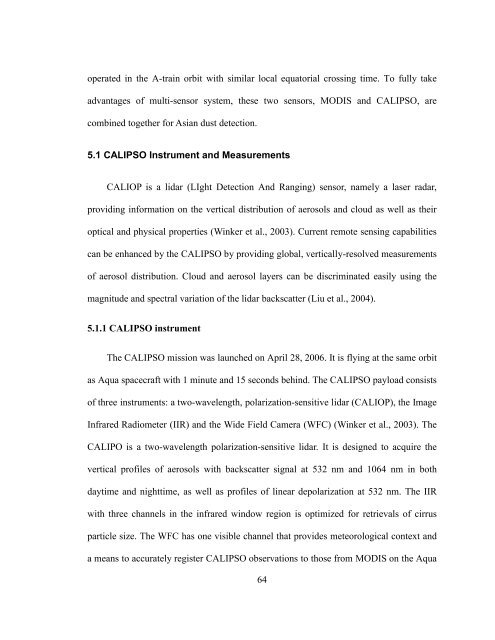i Detection of Smoke and Dust Aerosols Using Multi-sensor Satellite ...
i Detection of Smoke and Dust Aerosols Using Multi-sensor Satellite ...
i Detection of Smoke and Dust Aerosols Using Multi-sensor Satellite ...
You also want an ePaper? Increase the reach of your titles
YUMPU automatically turns print PDFs into web optimized ePapers that Google loves.
operated in the A-train orbit with similar local equatorial crossing time. To fully take<br />
advantages <strong>of</strong> multi-<strong>sensor</strong> system, these two <strong>sensor</strong>s, MODIS <strong>and</strong> CALIPSO, are<br />
combined together for Asian dust detection.<br />
5.1 CALIPSO Instrument <strong>and</strong> Measurements<br />
CALIOP is a lidar (LIght <strong>Detection</strong> And Ranging) <strong>sensor</strong>, namely a laser radar,<br />
providing information on the vertical distribution <strong>of</strong> aerosols <strong>and</strong> cloud as well as their<br />
optical <strong>and</strong> physical properties (Winker et al., 2003). Current remote sensing capabilities<br />
can be enhanced by the CALIPSO by providing global, vertically-resolved measurements<br />
<strong>of</strong> aerosol distribution. Cloud <strong>and</strong> aerosol layers can be discriminated easily using the<br />
magnitude <strong>and</strong> spectral variation <strong>of</strong> the lidar backscatter (Liu et al., 2004).<br />
5.1.1 CALIPSO instrument<br />
The CALIPSO mission was launched on April 28, 2006. It is flying at the same orbit<br />
as Aqua spacecraft with 1 minute <strong>and</strong> 15 seconds behind. The CALIPSO payload consists<br />
<strong>of</strong> three instruments: a two-wavelength, polarization-sensitive lidar (CALIOP), the Image<br />
Infrared Radiometer (IIR) <strong>and</strong> the Wide Field Camera (WFC) (Winker et al., 2003). The<br />
CALIPO is a two-wavelength polarization-sensitive lidar. It is designed to acquire the<br />
vertical pr<strong>of</strong>iles <strong>of</strong> aerosols with backscatter signal at 532 nm <strong>and</strong> 1064 nm in both<br />
daytime <strong>and</strong> nighttime, as well as pr<strong>of</strong>iles <strong>of</strong> linear depolarization at 532 nm. The IIR<br />
with three channels in the infrared window region is optimized for retrievals <strong>of</strong> cirrus<br />
particle size. The WFC has one visible channel that provides meteorological context <strong>and</strong><br />
a means to accurately register CALIPSO observations to those from MODIS on the Aqua<br />
64




![[Sample B: Approval/Signature Sheet] - George Mason University](https://img.yumpu.com/21978828/1/190x245/sample-b-approval-signature-sheet-george-mason-university.jpg?quality=85)


![[Sample B: Approval/Signature Sheet] - George Mason University](https://img.yumpu.com/18694905/1/190x245/sample-b-approval-signature-sheet-george-mason-university.jpg?quality=85)






![[Sample B: Approval/Signature Sheet] - George Mason University](https://img.yumpu.com/18694552/1/189x260/sample-b-approval-signature-sheet-george-mason-university.jpg?quality=85)

![[Sample B: Approval/Signature Sheet] - George Mason University](https://img.yumpu.com/18694474/1/190x245/sample-b-approval-signature-sheet-george-mason-university.jpg?quality=85)